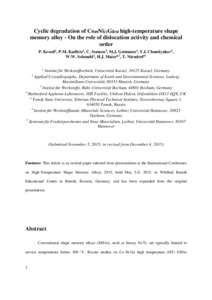| dc.date.accessioned | 2023-12-21T11:31:38Z | |
| dc.date.available | 2023-12-21T11:31:38Z | |
| dc.date.issued | 2015 | |
| dc.identifier | doi:10.17170/kobra-202312219261 | |
| dc.identifier.uri | http://hdl.handle.net/123456789/15315 | |
| dc.description | This version of the article has been accepted for publication, after peer review (when applicable) and is subject to Springer Nature’s AM terms of use, but is not the Version of Record and does not reflect post-acceptance improvements, or any corrections. | eng |
| dc.language.iso | eng | |
| dc.rights | Urheberrechtlich geschützt | |
| dc.rights.uri | https://rightsstatements.org/page/InC/1.0/ | |
| dc.subject | shape memory alloy (SMA) | eng |
| dc.subject | martensitic phase transformation | eng |
| dc.subject | functional degradation | eng |
| dc.subject | martensite stabilization | eng |
| dc.subject | superelasticity | eng |
| dc.subject.ddc | 620 | |
| dc.subject.ddc | 660 | |
| dc.title | Cyclic degradation of Co49Ni21Ga30 high-temperature shape memory alloy - On the roles of dislocation activity and chemical order | eng |
| dc.type | Aufsatz | |
| dcterms.abstract | Conventional shape memory alloys (SMAs), such as binary Ni-Ti, are typically limited to service temperatures below 100 °C. Recent studies on Co-Ni-Ga high temperature (HT) SMAs revealed the potential that these alloys can be used up to temperatures of about 400 °C. Analysis of the cyclic functional properties showed that degradation in these alloys is mainly triggered by intensive dislocation motion. However, data on the cyclic stress-strain response and the mechanisms leading to functional degradation of Co-Ni-Ga above 300 °C were missing in open literature. Current results reveal that above 300 °C diffusion controlled mechanisms, e.g. precipitation of secondary phases and changes in the chemical degree of order, seem to dictate cyclic instability. Detailed neutron and transmission electron microscopy analyses following superelstic cycling in a temperature range of 200 °C to 400 °C were employed to characterize the changes in degradation behaviour above 300 °C. | eng |
| dcterms.accessRights | open access | |
| dcterms.creator | Krooß, Philipp | |
| dcterms.creator | Kadletz, Peter M. | |
| dcterms.creator | Somsen, Christoph | |
| dcterms.creator | Gutmann, Matthias Josef | |
| dcterms.creator | Chumlyakov, Yuriy I. | |
| dcterms.creator | Schmahl, Wolfgang Wilhelm | |
| dcterms.creator | Maier, Hans Jürgen | |
| dcterms.creator | Niendorf, Thomas | |
| dc.relation.doi | doi:10.1007/s40830-015-0049-5 | |
| dc.subject.swd | Memory-Legierung | ger |
| dc.subject.swd | Hochtemperaturverhalten | ger |
| dc.subject.swd | Martensitumwandlung | ger |
| dc.subject.swd | Degradation <Technik> | ger |
| dc.subject.swd | Pseudoelastizität | ger |
| dc.type.version | acceptedVersion | |
| dcterms.source.identifier | eissn:2199-3858 | |
| dcterms.source.issue | Issue 1 | |
| dcterms.source.journal | Shape Memory and Superelasticity | eng |
| dcterms.source.pageinfo | 37-49 | |
| dcterms.source.volume | Volume 2 | |
| kup.iskup | false | |

